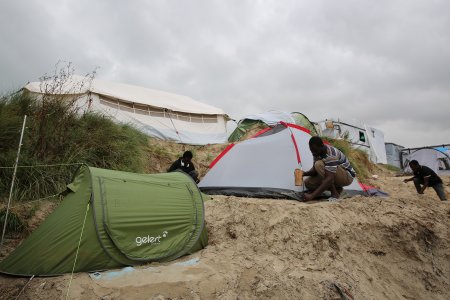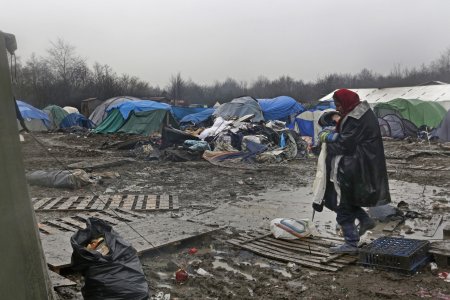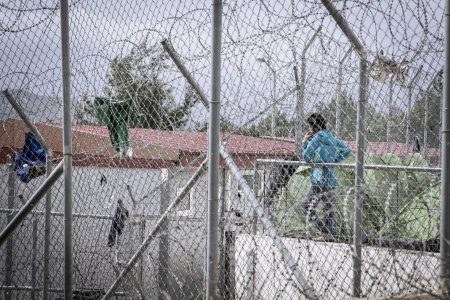Libya: the forgotten ones
Michaël Neuman
Michaël Neuman spent ten days in Libya with Médecins Sans Frontières teams working in detention centres for migrants. From his stay, he brings back the following impressions that illustrate the gloomy situation of the people who are held there, for months or years, and the even more difficult situation of all those subject to kidnapping and torture.
It’s departure season. Makeshift boats with men, women and children aboard are taking to the sea one after the other. Since the beginning of the year, 2300 people have made it to Europe - and more than 2000 have been intercepted and brought back to Libya by coastguards trained and financed by Europeans. For some of them, reaching Europe has always been their goal. For others, the choice came after being caught up in human trafficking rings and subjected to torture and abuse. Their routes cross here, but their reasons for leaving their home countries are rarely univocal. It is February 2020 and many people are waiting to try their luck. They left from Tripoli, Khoms, and Sabratha… cities where conflict, business interests, tribalism, semblances of a functioning state and corruption intermingle. Libyans are not spared by the effects of unrest and war. Yet, visitors are struck by how normal life seems here. The packed fruit and vegetable markets and heavy traffic clogging up the streets of Tripoli appear to confirm this normality, but in fact reflect a city groaning under the weight of the displaced people arriving in large numbers from areas affected by the country’s war of attrition between the Libyan interim government, which still reigns over Tripoli and part of the west coast, and the LNA, led by Field Marshal Haftar who controls much of the rest of the country. International powers - Italy, France, Russia, Turkey and United Arab Emirates - have gradually joined the fray, transforming Libya into a powder keg liable to explode with every warning shot fired by one of the belligerents. And today, as a result of the head-to-head between Erdogan and Putin, developments in the conflict depend as much on events in Idlib, Syria, as in Tripoli.
This then is the war-torn country in which the European Union is deploying its policy of support to the interception and return of "migrants". We are talking the full works: the financing and training of Libyan coastguards, the delegation of sea rescue to merchant vessels, the intimidation of NGO rescue boats, the suspension of Operation Sophia, etc. And nothing helps : not the bombings of Tripoli's port and airport, nor the rocket attacks on detention centres in close proximity to military installations, not even the witness accounts of the appalling living conditions in these detention centres, the misappropriation of international funding or the extreme precarity of the migrants living in Libya’s cities are enough to shake European certitudes. Hypocrisy reigns: the European Union claims to be against detention while cultivating it with its support for the Libyan interception system; the United Nations High Commissioner for Refugees condemns interceptions at sea without ever mentioning the responsibility of the Europeans.
Eleven detention centres are currently placed under the responsibility of the Libyan Directorate for Combating Illegal Migration (DCIM). The list changes regularly, but we do not always know why. Nor do we know whether the disappearance of a centre really means that it has been emptied of its detainees, or whether they are still living there under some informal and probably even more violent regime. Once in these centres, people never know when they will get out: some escape, others manage to buy their way out, many rot there for months or even years. The waiting is physically and psychologically devastating. This is the fate of the detainees in Dar El Jeb, near Zintan in the Nafusa mountains, far removed and completely forgotten: most of them – Eritreans - have been there for two years or even longer.
There is not enough food to go round and the cells - which the migrants are rarely allowed to leave - are dark and either very cold or very hot. The long days are punctuated by the sound of keys in locks and rattling bars. In the night of Saturday 29 February to Sunday 1st March 2020, ten days or so after I left, a fire – no doubt accidental – in the Dar El Jebel detention centre claimed the life of a young Eritrean man.
We can certainly confirm that the work begun in these centres, the focus on improving the living conditions, the medical consultations, the food supplements, and also - and perhaps most importantly - our physical, visible and regular presence have helped to humanise them, and even to reduce the levels of violence. But we also know that any progress made is fragile, easily undermined by a shift in the local equilibrium, a change of guards, trust gained and then lost and the services we render. It is not rare to hear the directors of these centres explain that women and children do not belong in these places; nor is it rare for them to inflict severe punishment on anyone who tries to escape. Some of them starve their detainees; others let them out when the company hired to provide meals suspends its services because it has not been paid. Yet, if the doors of some of these detention centres were to be thrown open, many of the detainees would probably stay inside, preferring the precarious existence they know to the frightening uncertainties outside. Our teams have been told as much by many people. In this fragmented country, local political dynamics and stakes dominate. Something we learn quickly in Libya is that it is impossible to generalise a situation.
We are equally certain that it is not our vocation to become the health service of a system of arbitrary detention. These people must get out. They are mostly men, but there are also women and children, sometimes very young, sometimes born out of rape, sometimes born in detention. Exposure to violence, vulnerability to militia and people traffickers, and the possibility for inmates to work and earn some money vary considerably from one centre to another - as do the chances of humanitarian aid organisations to gaining space to work.
And most importantly, we know that the official detention centres only hold two or three thousand of the endangered migrants in Libya. So, what about the others? Many of them work, living the precarious existence that is the lot - to varying degrees, of course – of so many immigrants around the world, from Dubai to Paris, Khartoum to Bogota. But several tens of thousands more, either through bad luck or because they do not want to make a life in Libya, resort to the untrustworthy services of people traffickers and are at very high risk of abduction, of course, kidnapping for ransom, torture and abuse. Some of these “migrants”, somewhere between 45,000 and 50,000, mostly from Eritrea, Sudan or Somalia, are recognised as “refugees or asylum seekers” by the High Commission for refugees. Vast numbers of others, from Nigeria, Mali, Morocco, Guinea, Bangladesh, etc., are considered “economic migrants”. They are the most alone.
For those in detention centres, there is a still a slight chance of being relocated. Last year, the HCR was able to organise the departure of 2400 people to Niger and Rwanda, where they were once again placed in centres while they waited for another country, usually European, to accept them. At this rate, it will take 20 years to evacuate everyone – and that’s without counting the new arrivals. Furthermore, the “resettlement” programme gives priority to people identified as vulnerable, i.e. women, children and the sick. Single adult men – which includes most of the Eritreans, for example - have little chance of being among the rare people selected. But deeply in debt and with legitimate fears for their safety in their home country, they will not return under any circumstances. Having lost faith in the HCR's ability to get them out – their only remaining hope is a dangerous and unlikely crossing of the Mediterranean.
When the HCR does get people out of detention centres, as there are no other safe places, it sends them to the cities, mainly Tripoli, where they become “urban refugees” and receive a one-time-only aid package that it so basic that it is hard to see what protection it could possibly offer anyone. In the city, migrants are once again at the mercy of people traffickers and violence. This is what happened to two Eritreans, who were killed, last January. And yet these two had spent some time under the protection of the HCR at its Gathering and Departure Facility. The HCR opened this centre in Tripoli at the end of 2018. Co-managed with the Libyan authorities, it was initially designed to facilitate the evacuation of asylum seekers to other countries. Originally intended to accommodate 1,000 people, it did not survive for much more than a year, falling foul of the conflict that set the capital ablaze in April 2019 and the proximity of fighting militia.
In any case, some people prefer the certain precarity of detention centres to the even more worrying uncertainty of living outside: consequently, we regularly see people returning to them. In January, four Somali women, ordered to leave the GDF in January, chose to take a taxi and join their husbands who were being held at Dar El Jebel and from whom they had been separated by the HCR which does not recognise the legality of couples. After the false promises of evacuation, they are now faced with an additional absurdity: people registered with the HCR are not entitled to benefit from the International Organisation for Migration’s voluntary repatriation system, even if they wanted to.
For everybody else, unprotected by the HCR, the horizon is no more glowing. For them too, the only possibility of reaching Europe is a dangerous sea crossing. The alternative is a return home, promoted and organised by the International Organisation for Migration and felt by many to be an insuperable defeat. The IOM has organised more than 40,000 of these returns since 2016. In 2020, around 10,000 people are likely to accept a “voluntary departure”. A more absurdly inappropriate name for it would be hard to find… At least, these ones will be done with their Libyan experience.
The situation of migrants in Libya is both banal and exceptional. Exceptional because of the intense violence to which a large number of them are exposed – the violence of people traffickers and kidnappers, the violence of possibly dying at sea and the violence of war. But it is also terrifyingly banal: there is little difference between an Eritrean living with the rats under the Parisian bypass and in a detention centre in Khoms. Their experience of migration is incredibly violent, their situation is precarious and dangerous. The situation of a Darfuri in Agadez is not much better, nor that of an Afghan in Samos, Greece. It is difficult not to see this population - unable to move in this world of global mobility - as the most unwanted among the unwanted. They are the forgotten ones.
To cite this content :
Michaël Neuman, “Libya: the forgotten ones”, 2 mars 2020, URL : https://msf-crash.org/en/blog/camps-refugees-idps/libya-forgotten-ones
If you would like to comment on this article, you can find us on social media or contact us here:
Contribute




Add new comment